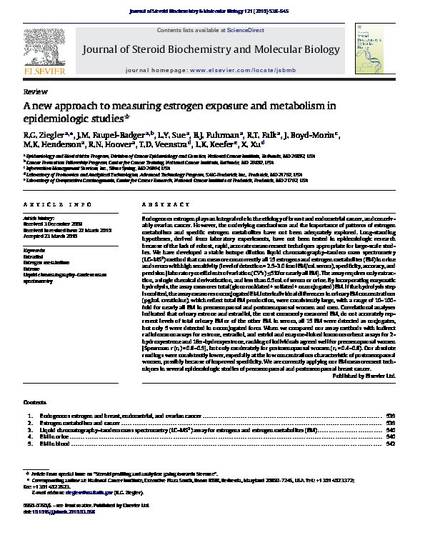
Endogenous estrogen plays an integral role in the etiology of breast and endometrial cancer, and conceivably ovarian cancer. However, the underlying mechanisms and the importance of patterns of estrogen metabolism and specific estrogen metabolites have not been adequately explored. Long-standing hypotheses, derived from laboratory experiments, have not been tested in epidemiologic research because of the lack of robust, rapid, accurate measurement techniques appropriate for large-scale studies. We have developed a stable isotope dilution liquid chromatography-tandem mass spectrometry (LC-MS(2)) method that can measure concurrently all 15 estrogens and estrogen metabolites (EM) in urine and serum with high sensitivity (level of detection=2.5-3.0fmol EM/mL serum), specificity, accuracy, and precision [laboratory coefficients of variation (CV's) < or =5% for nearly all EM]. The assay requires only extraction, a single chemical derivatization, and less than 0.5mL of serum or urine. By incorporating enzymatic hydrolysis, the assay measures total (glucuronidated+sulfated+unconjugated) EM. If the hydrolysis step is omitted, the assay measures unconjugated EM. Interindividual differences in urinary EM concentrations (pg/mL creatinine), which reflect total EM production, were consistently large, with a range of 10-100-fold for nearly all EM in premenopausal and postmenopausal women and men. Correlational analyses indicated that urinary estrone and estradiol, the most commonly measured EM, do not accurately represent levels of total urinary EM or of the other EM. In serum, all 15 EM were detected as conjugates, but only 5 were detected in unconjugated form. When we compared our assay methods with indirect radioimmunoassays for estrone, estradiol, and estriol and enzyme-linked immunosorbent assays for 2-hydroxyestrone and 16alpha-hydroxyestrone, ranking of individuals agreed well for premenopausal women [Spearman r (r(s))=0.8-0.9], but only moderately for postmenopausal women (r(s)=0.4-0.8). Our absolute readings were consistently lower, especially at the low concentrations characteristic of postmenopausal women, possibly because of improved specificity. We are currently applying our EM measurement techniques in several epidemiologic studies of premenopausal and postmenopausal breast cancer.
- Chromatography,
- liquid,
- epidemiologic studies,
- estrogens,
- tandem mass spectrometry
Available at: http://works.bepress.com/timothy-veenstra/84/
